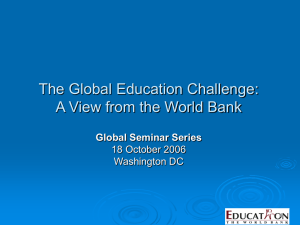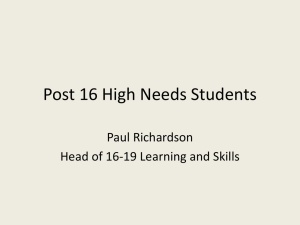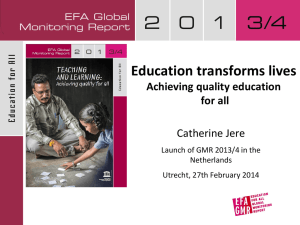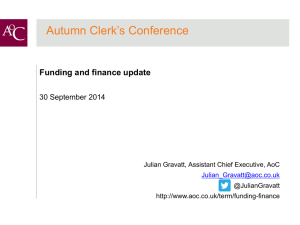Slide 1 - Unicef
advertisement
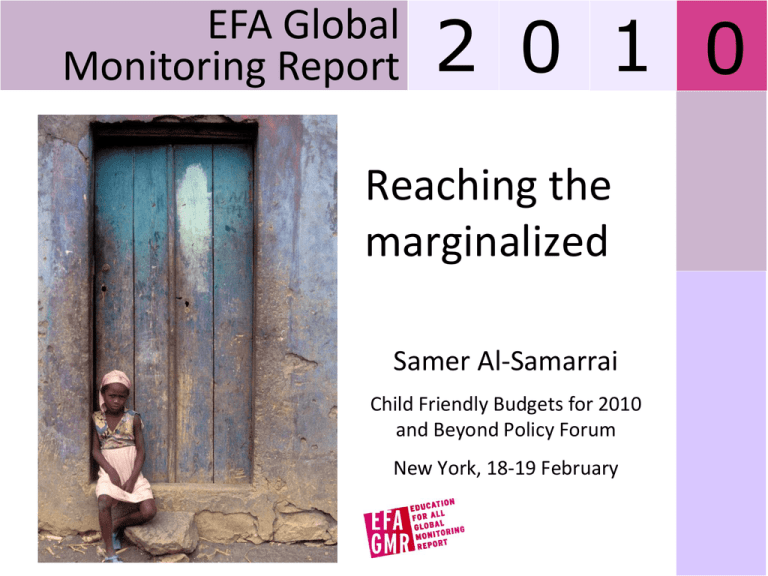
EFA Global Monitoring Report 2 0 1 0 Reaching the marginalized Samer Al-Samarrai Child Friendly Budgets for 2010 and Beyond Policy Forum New York, 18-19 February Education for All Global Monitoring Report 2010 Education at risk: the impact of the financial crisis Despite progress world ‘off track’ to achieve EFA goals ‘Aftershock effects’ will hamper progress particularly for marginalized groups: – rising poverty and levels of malnutrition – mounting fiscal pressures and slower economic growth will limit education financing – Increased aid vital for creating fiscal space but aid is under threat. Education for All Global Monitoring Report 2010 Numbers of out-of-school children are declining, but not fast enough Out-of-school children (millions) Out-of-school children 120 105 million 4 8 6 Latin America and the Caribbean Arab States RestAsia of the World East and the Pacific 100 72 million 80 Latin America and the Caribbean Arab States 9 East Asia and the Pacific South and West Asia 39 million 3 6 56 million 60 40 18 8 million Sub-Saharan Africa 20 45 million 32 23 million 0 1999 2000 2001 2002 2003 2004 2005 2006 2007 2008 2009 2010 2011 2012 2013 2014 2015 14 The case of Nigeria Ukraine 12 Average number of years of schooling Education for All Global Monitoring Report 2010 Education marginalization – inequalities within countries Cuba 10 years 9.7 years 10 Bolivia Indonesia Richest 20% Rural Urban 10.3 years Rich. rural boys Rich. urban boys Rich. rural girls Boys Girls 8 Honduras 6 4 Nigeria Cameroon 6.7 years Bangladesh Urban 6.4 years Education poverty Poorest 20% Chad 2 0 Poor. urban boys 3.5 years Rural 3.3 years Poor. rural girls 2.6 years Extreme education poverty Somalia Rural Hausa 0.5 years Poor. rural Hausa girls 0.3 years Education for All Global Monitoring Report 2010 Consequences of the crisis on education Increased levels of poverty and rising levels of malnutrition will have irreversible consequences in education: – Undermines cognitive development and causes irreversible losses in opportunities for learning – Reductions in household spending on education – Withdrawal of children from school Negative consequences likely to fall disproportionately on the most vulnerable Education for All Global Monitoring Report 2010 Budget monitoring Little evidence that low-income countries cut public spending in 2009 – Most countries in SSA planned increases in expenditure on education – Only two countries planned to cut education expenditure (Benin and Ghana) …. but problems with monitoring Education for All Global Monitoring Report 2010 Economic growth matters for education financing 30% 25% 20% 15% 10% 5% 0% -5% -10% total change in real primary education spending Change due to GDP growth Change due to revenue collection Change due to education budget allocation Change due to primary education budget allocation 1.0 Pre-crisis projections 0.0 Constant PPP 2006 US$ billions Education for All Global Monitoring Report 2010 Education financing could suffer from slower growth -1.0 -2.0 -3.0 Total education spending -4.0 Primary education spending -5.0 -6.0 2009 2010 Education for All Global Monitoring Report 2010 Fiscal space constrained in most countries off-track Room for manoeuvre is limited Many countries with extremely limited fiscal space furthest off track for achieving EFA Aid has the most immediate potential for protecting social sector budgets Disbursements are rising, however commitments fell by 22% in 2007, to US$4.3 billion. Total aid to education Constant 2007 US$ billions Education for All Global Monitoring Report 2010 Aid commitments to basic education – a worrying picture Total aid to basic education 12.3 12.1 12.0 9.5 8.2 3.2 7.6 7.9 3.2 3.4 3.4 10.4 4.5 9.9 5.6 4.0 5.5 4.3 1999 2000 2001 2002 2003 2004 2005 2006 2007 Commitments Education for All Global Monitoring Report 2010 Rising to the EFA challenge Set equity-based targets for all EFA goals and monitor their progress. Monitor early warning impacts – budgets, health/education indicators, and vulnerable groups Changes in public spending need to be pro-poor. Increase resource mobilization and strengthen equity in public spending. Identify the drivers of marginalization for specific groups and adopt integrated policies that address them. Scale up support for social protection to protect productive assets, health and education Honour aid commitments and strengthen the multilateral architecture for aid to education. EFA Global Monitoring Report 2 0 1 0 www.efareport.unesco.org
